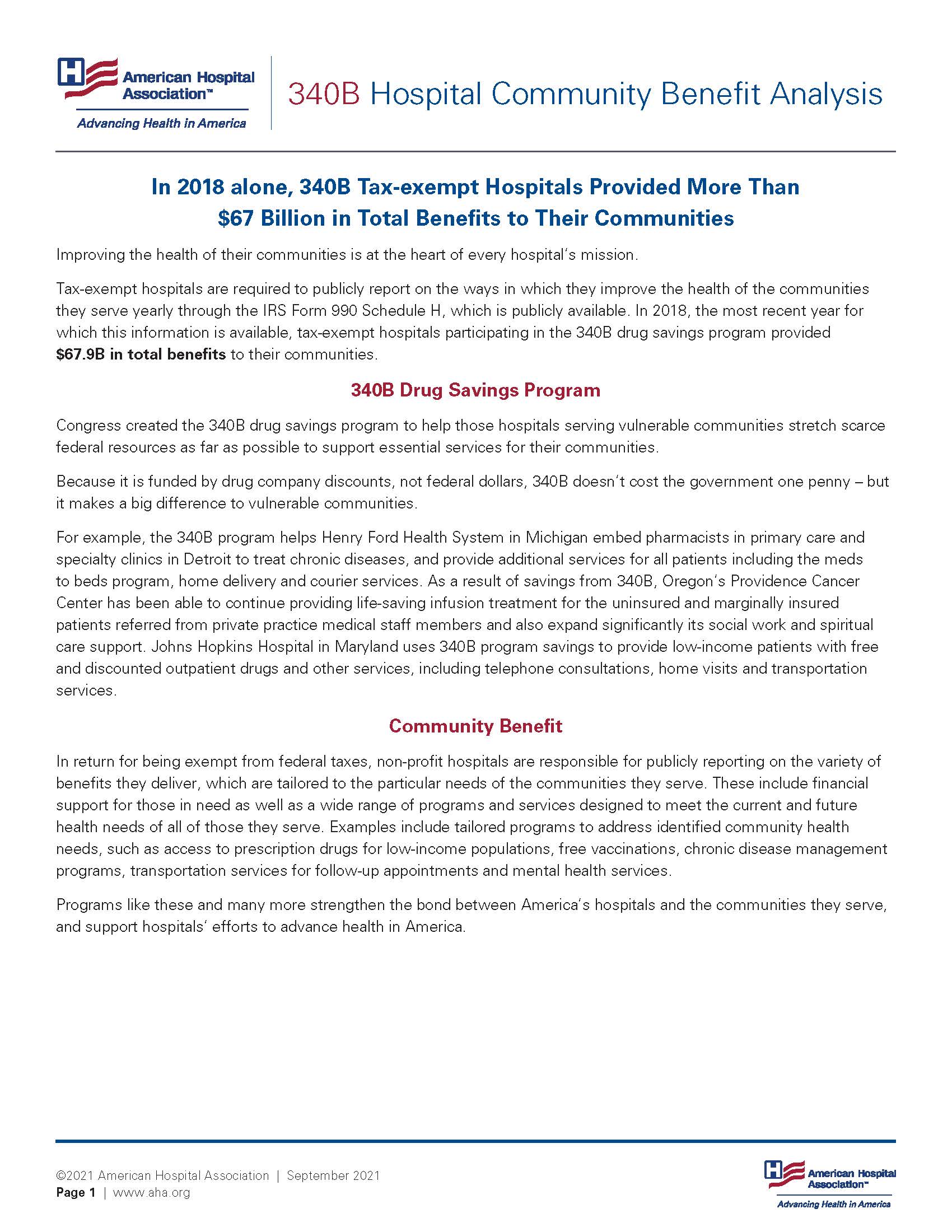2021 340B Hospital Community Benefit Analysis
In 2018 alone, 340B Tax-exempt Hospitals Provided More Than $67 Billion in Total Benefits to Their Communities
Improving the health of their communities is at the heart of every hospital’s mission.
Tax-exempt hospitals are required to publicly report on the ways in which they improve the health of the communities they serve yearly through the IRS Form 990 Schedule H, which is publicly available. In 2018, the most recent year for which this information is available, tax-exempt hospitals participating in the 340B drug savings program provided $67.9B in total benefits to their communities.
340B Drug Savings Program
Congress created the 340B drug savings program to help those hospitals serving vulnerable communities stretch scarce federal resources as far as possible to support essential services for their communities.
Because it is funded by drug company discounts, not federal dollars, 340B doesn’t cost the government one penny – but it makes a big difference to vulnerable communities.
For example, the 340B program helps Henry Ford Health System in Michigan embed pharmacists in primary care and specialty clinics in Detroit to treat chronic diseases, and provide additional services for all patients including the meds to beds program, home delivery and courier services. As a result of savings from 340B, Oregon’s Providence Cancer Center has been able to continue providing life-saving infusion treatment for the uninsured and marginally insured patients referred from private practice medical staff members and also expand significantly its social work and spiritual care support. Johns Hopkins Hospital in Maryland uses 340B program savings to provide low-income patients with free and discounted outpatient drugs and other services, including telephone consultations, home visits and transportation services.
Community Benefit
In return for being exempt from federal taxes, non-profit hospitals are responsible for publicly reporting on the variety of benefits they deliver, which are tailored to the particular needs of the communities they serve. These include financial support for those in need as well as a wide range of programs and services designed to meet the current and future health needs of all of those they serve. Examples include tailored programs to address identified community health needs, such as access to prescription drugs for low-income populations, free vaccinations, chronic disease management programs, transportation services for follow-up appointments and mental health services.
Programs like these and many more strengthen the bond between America’s hospitals and the communities they serve, and support hospitals’ efforts to advance health in America.
340B Hospitals: Total Benefits to the Community
| Type of Benefit* Provided | % of Total Hospital Expenses | Dollars Spent |
|---|---|---|
| Financial Assistance, Unreimbursed Medicaid, and unreimbursed costs from means-tested government programs | 6.5% | $32,215,115,197 |
| Other benefits, including health professions education, medical research, cash and in-kind contributions to community groups | 4.6% | $22,981,689,128 |
| FINANCIAL ASSISTANCE AND CERTAIN OTHER COMMUNITY BENEFITS | 11.1% | $55,196,804,325 |
| Community-building activities | 0.1% | $349,204,332 |
| Medicare Shortfall | 2.1% | $10,547,013,853 |
| Bad debt expense attributable to financial assistance | 0.4% | $1,895,821,795 |
| TOTAL BENEFITS TO THE COMMUNITY | 13.7% | $67,988,844,305 |
*Schedule H Part I.7, Part II, Part III A.3, B.7
How Benefits Were Calculated
The AHA contracted with Guidestar to create a file of all electronic IRS Form 990 Schedule H data submitted for the 2018 tax year. Using that data file, AHA identified 1,107 individual hospital Schedule Hs that represent 72% of exempt hospitals with 340B status and another approximately 435 340B hospitals as part of group filings that include non-340B hospitals. Using Schedule H data from the 1,107 340B hospitals, a representative sample of all 340B non-government exempt hospitals, and AHA Annual Survey data, AHA calculated the percent of total hospital expenses and dollars spent on benefits to the community by 340B hospitals. A more detailed technical appendix describing AHA’s methodology is available upon request. Ernst & Young (EY) confirmed that “the methodology described above is consistent with the approach used by EY in our prior analyses of the Form 990 Schedule H.”


